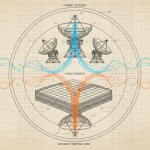The Bedrock: Motion, Matter, and Meaning
Everything is material in motion. This simple insight, rooted in pre-Socratic philosophy yet validated by modern physics, forms the foundation of all work presented here.
For too long, archaeology and the human sciences have operated under dualistic frameworks that separate mind from matter, culture from nature, organism from environment. These artificial divisions create conceptual barriers that prevent us from understanding technology, evolution, and human development as unified processes.
Core Principles:
Monistic Ontology – There is one material universe. No separate realm of “culture,” “ideas,” or “information” exists independently of physical processes. Everything we study—from stone tools to social systems—is matter in motion.
Technology Defined – Technology is not “applied knowledge” or “cultural trait.” It is physical extensions combined with somatic motion patterns that alter the speed and scale at which organisms interact with their environment. This is fundamentally a relativistic transformation—tools change the organism’s effective size and motion capabilities.
Embodiment & System Boundaries – Organisms exist in continuous feedback with their environments. The boundary between organism and environment is not a barrier but an active interface where innovation occurs. Technology represents an extension of this boundary through controlled motion of material.
Somatic Motion as Selective Force – Motion patterns are not merely “behavior”—they are environmental structures that exert selective pressure. When hominins began habitually using tools, they altered their own selective environment by requiring new motion patterns, creating evolutionary feedback loops.
Time as Spatial Geometry – Archaeological time is not a linear sequence of periods. It is spatial geometry within 3D manifolds where temporal relationships are encoded as geometric properties. This paradigm shift enables integration with physics frameworks and GPU-accelerated pattern recognition.
This foundation generates two complementary applications: understanding the past through archaeological signal reconstruction, and shaping the future through engineering that respects material reality and motion constraints.
Connections:
- Generates the framework for → Signal Science
- Applied to the past in → Archaeological Research
- Applied to the future in → Engineering & Design
Articles
Research Papers
IEEE Paper for ISSC Conference Letterkenny ATU 2025 – final draft version – the proceedings will be published on IEEE Xplore shortly.
Archive
Problem with Progress in Irish Archaeology : Letter to Archaeology Ireland, 2009
Download PDF
Dualism: The “Great Divide” in the Philosophy of Archaeology, 2014, Unpublished.
Download PDF
“οὐκ ἐμοῦ, ἀλλὰ τοῦ λόγου ἀκούσαντας ὁμολογεῖν σοφόν ἐστιν ἓν πάντα εἶναί“
Heraclitus B50 – Quoted by Hippolytus in his Refutation of All Heresies
“Having listened not to me but to the logos, it is wise to agree that all things are one“
